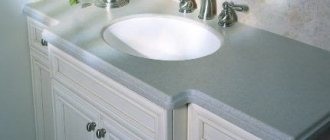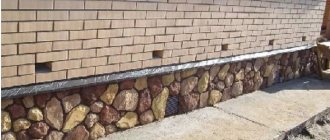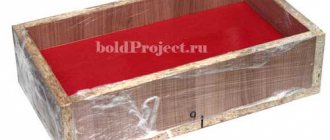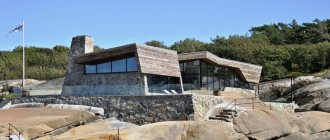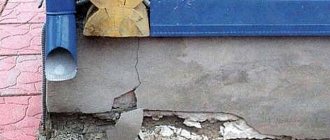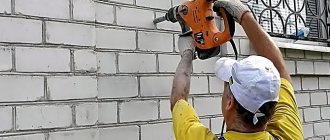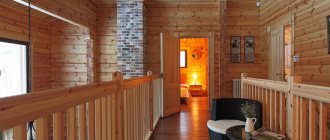Required tools and materials
At the site of installation of the monument, the soil is first examined.
Neighboring burial sites will be a good guide. On stable ground, the monuments look level and do not warp anywhere. You can make a foundation even for heavy slabs and tombstones. On clay soil, strip foundations are laid under massive ritual complexes. In sandy soils, without going deep, a strip base is made.
Preference is given to the construction of small and medium-sized monuments
The main focus of the project is on the center of gravity. In the most difficult place, the foundation is thoroughly strengthened
Particular strength keeps the structure in good condition for many years.
Inventory:
- Shovels;
- Roulette;
- Putty knife;
- Master OK;
- Rubber mallet;
- Hard rubber from 5 mm;
- Building level.
Mix the solution in a bucket or special container. If dismantling is carried out, you will need a crowbar.
Equipment:
- Reinforced concrete beams - three pieces;
- One reinforcement each with a diameter of 16 mm, a length of 30 cm and 14 by 15.
Standard set of material:
- Glue;
- Boards;
- Sand;
- Cement;
- Crushed stone.
A base made of durable metal is used at the place of optimal load.
Advantages of rubble foundations
Thanks to the special strength of the stone, the durability of structures reaches 150 years or more. There are known structures made of natural stone that are hundreds of years old.
As a natural material, rubble stone is not afraid of sudden temperature changes. It is highly resistant to aggressive groundwater.
But for all its positive qualities, rubble foundations require a lot of labor. Foundations made of this material are massive and large in size, which cannot be said about concrete structures, which, although small in size, due to the presence of a reinforcement frame, can withstand the same loads as rubble concrete.
It is also inadvisable to make columnar foundations from rubble stone; too much effort and material will be required. Therefore, here we will consider the construction of a strip foundation made of rubble.
It must be said that the use of rubble is justified in the case when the price of foundation stone is significantly lower than the cost of a concrete strip foundation. Otherwise, the game will not be worth the candle, as they say. Working with stone is heavier than the work of constructing concrete structures, so you need to think seven times before deciding on this labor-intensive task.
Some tricks in constructing a rubble base
To achieve a fairly good result, you need to know something about how to simplify your work and at the same time increase its efficiency:
- the solution that will be used for pouring must be stirred periodically with a vibrator until the end of work;
- if something interferes with your work and you are forced to suspend it for more than one day, you need to create a special coating that will protect the structure from drying out. When resuming work, do not forget to clean and slightly wet the entire structure with water. Without doing this, you can break the adhesion with the other layer;
- To continue laying the rubble, you need to prick the mortar that has frozen with something sharp and remove all unnecessary parts. As a result, the cement mixture will adhere well;
- if laying is carried out in a trench with gentle slopes, then a working platform is created in the space between its wall and the structure itself;
- steep slopes of the trench must be equipped with scaffolding, installing them on the outside of the foundation;
- for convenience, it is best to use the help of at least one more person;
- If necessary, the walls in the trench are reinforced with wooden panels with supports.
In order to build a strip foundation from rubble stone, you need to prepare a cement mortar. It is almost the same as for laying brick materials. Powder grade M 400 or M 500 is used for preparation. To prevent the concrete from cracking in the end, the sand should not contain clay particles. It also needs to be cleaned of various debris and all kinds of impurities.
Initially, you need to mix cement and sand, and then add water. The consistency of the solution should resemble sour cream.
When laying a strip base made of rubble, you can use 3 methods: pouring, “under the blade” and “under the bracket”.
The first is chosen when constructing small buildings no higher than 10 meters. The stone used is different and is not selected. On top of the laid blocks, pour crushed stone (a layer of 5-10 centimeters) and compact it well.
After the preparatory work, the rows are filled with concrete mixture. Remember that the material is initially laid dry, and only then the solution is poured. Using a vibrating compactor, it is distributed over all the voids that have arisen. These measures will greatly increase the strength and reliability of the foundation.
The other two methods are characteristically different from the first. First of all, it requires careful selection of stones. When laying them there should be minimal gaps and voids. These options are of course optimal, but require a lot of time and additional labor costs. The stone blocks are laid out horizontally, and in order to achieve absolute evenness along the entire length of the foundation, a rope is pulled. And the main aspect is the presence of rubble stones of approximately equal size.
A little about the stone
Natural stone is a fairly strong and durable material. It is used not only for foundation construction, but also for the construction of walls, barbecues, and barbecues. It has found its application in landscape design. In addition, natural cut stone is currently actively used in construction as a facing material.
The stone has found such widespread use due to its properties:
- Durability.
- Environmentally friendly.
- Aesthetics.
- Strength.
- Resistance to all adverse climatic and chemical influences.
However, not every stone can be used in construction work.
Soft and exfoliating rocks do not provide sufficient strength, so rubble stone, which is irregularly shaped rock fragments, is chosen to construct the foundation of the house.
When thinking about constructing a rubble stone foundation, stones with a flat shape are chosen, since they are easier to lay in rows, held together with cement mortar. Particularly large ones will have to be split or trimmed.
Laying stone in the foundation
Rubble stone can be placed both in the formwork and directly in the trench. Formwork should be installed if the soil is crumbling. In this case, instead of formwork, you can use roofing felt, roofing felt and other roll or sheet materials
It is important to prevent soil from getting inside the foundation, as this will weaken the adhesion strength of the stones to the mortar.
Any foundation must be placed below the freezing level of the soil if it is heaving or excessively wet, and rubble is no exception. On the contrary, a foundation made of natural stone must lie below the freezing point of the soil, since rubble foundations are usually not reinforced, and in severe frosts there is a risk of the foundation bulging along with the frozen soil. This applies, as mentioned above, to heaving and moisture-saturated soils. For strong and dry soils, the depth of the foundation must be at least 50 cm. All this is determined at the design stage.
A sand bedding is made at the bottom of the trench, on which the largest stones are placed, pressing them with great force into the sand. The stones should take a stable position and not wobble. The width of the foundation should be 15-20 cm greater than its height.
When building a stone foundation for a house, it is necessary to carefully select stones of a more regular shape for the corners and the first row. If necessary, you need to shape them using a sledgehammer and chisel. The voids formed between the stones are filled with smaller fractions, after which the row is filled with liquid cement and a bed of normal cement-sand mortar is laid on top. The next row of stones is installed on it.
The stones must be selected according to their shape so that they are laid with minimal gaps. Be sure to adhere to the dressing, as in brickwork, otherwise the entire foundation will quickly crumble.
The space formed by the stone foundation and the trench wall is filled with small crushed stone from the same stone. Thus, a drainage layer is formed, which helps drain water from the foundation.
If reinforcement is necessary (this also happens), reinforcement is used only in the form of vertical rods and wire.
When installing a rubble foundation, you should immediately leave ventilation holes so as not to use a hammer drill later.
If you want to give your house a solid and rich appearance, you can simply cover the foundation with stone. This is much easier than setting up the actual base of their rubble stone. In this case, the stone, which is cut into flat tiles, is attached using special glue or cement mortar. If the stone is heavy, then metal hooks or reinforcing mesh are used to secure it.
About the site
zalman
Pros and cons of using
The use of granite or granite tiles for plinth cladding has several advantages:
- the chemical stability of the rock and its high density make it possible to protect walls and foundations from the harmful effects of precipitation;
- unique stone texture;
- large range of shades;
- durability;
- UV resistance for many years.
There are several disadvantages that make it difficult to do it yourself. If stone is used, then it is better to involve professionals.
Important and useful information about finishing the base with natural and artificial stone is presented in this section.
Design Features
What is a stone foundation? This is the foundation of the house, built from natural stone; the voids in it are filled with fine crushed stone, and cement-sand mortar is used for adhesion. Experts say that such a supporting structure is several times stronger and more durable than a conventional strip foundation.
The peculiarity of the structure is that natural stone cannot be divided into certain categories depending on the shape and size of individual elements. The level of strength does not depend on the shape of the stones used to build a natural stone foundation. Rubble stone is used in the construction of one- and two-story buildings:
- spending a minimum of financial resources;
- without using construction equipment;
- without needing the help of highly qualified specialists.
Another positive feature that distinguishes natural stone is its visual appeal and aesthetics. A plinth made of cobblestones does not need to be plastered, which reduces material and physical costs.
Constructing a stone foundation makes sense on various types of soil:
- loamy;
- sandy;
- clayey.
Most often, when constructing the foundation for a house, rubble stone or cobblestones are used.
In such conditions, the service life of the building is at least 50 years, which largely depends on the quality of the foundation stones.
The use of rubble stone for the construction of foundations in areas rich in this natural material is justified. This is due not only to a significant reduction in material costs, but also to the characteristics of the soil, which is characterized by increased strength in such places.
In order to strengthen the structure, reinforcing components are used, which are introduced into the base itself before pouring the cement mortar. In this case, the structure will serve for a long time without requiring additional maintenance. When choosing a stone, it is enough to check its strength using a regular hammer or sledgehammer.
Time costs are associated with the preparation of elements. Each stone will have to be thoroughly cleaned of any contaminants and additionally washed with water to ensure a high-quality bond of the cement mortar with the structural elements.
The use of limestone should be abandoned, as it is not very durable.
Advantages of granite
The performance characteristics of this natural stone are so superior to its analogues that it is most often used for the implementation of expensive projects. Due to its excellent strength and aesthetic parameters, granite is actively used during construction, design of interiors and exteriors of residential, commercial, administrative and other buildings. It is ideal for landscaping parks, local areas and other objects.
The most common colors of granite blocks are pink and gray shades. More rare and, accordingly, more expensive colors are black, blue, yellow, beige. This natural stone has different types of crystal structure. Depending on the diameter of the grains, there are coarse-grained granite (more than 5 mm), medium-grained (2-5 mm) and fine-grained (about 2 mm). The latter is considered the most durable, although other types also do not lose their integrity for several centuries.
- high strength;
- resistance to wear, friction, compression;
- wide palette of shades and variability of textures;
- resistance to atmospheric factors and aggressive substances;
- ease of care for granite coatings and products;
- exceptional aesthetic potential;
- waterproof;
- durability.
AMG Group supplies standard and large granite blocks. The products meet global environmental standards. Customers are guaranteed fast delivery in St. Petersburg and other cities.
Visiting ancient castles, fortresses, and cities always evokes admiration for the grandeur of the buildings and their amazing durability. My home is my fortress, they said in those distant times, when the main building material was natural stone, and the construction of cities began with the construction of a fortress wall. Actually, thanks to the strength of the stone foundations and walls, for the construction of which they used cobblestones, boulders, and, over time, granite blocks, they have survived to this day.
Today there is no particular need to make an impregnable fortress out of your home, however, the strength, reliability and originality of buildings made of natural stone still attracts the attention of architects and designers to create projects and bring them to life.
Laying the foundation
Choosing granite as a material for constructing the foundation of a house means not only receiving a number of advantages due to its physical and mechanical characteristics:
- exceptional strength;
- resistance to external influences;
- non-critical to the type of soil on the site (except for highly heaving ones);
- accessibility for use in areas of possible flooding;
- possibility of use in various types of foundations (strip, column, mixed type);
You will also need to meet certain requirements for the preparation and order of its laying:
- accuracy of calculations of foundation parameters, taking into account the depth of soil freezing and the width of walls;
- clear markings on the site;
- laying the foundation not only for external, but also for all load-bearing walls;
- compliance with the work technology - laying in rows on concrete mortar with mandatory bandaging, similar to brickwork;
- laying communications or reserving holes and channels for their subsequent installation.
The best results in terms of durability and resistance to destruction as a result of natural factors are given by gabbrodiabase granite, whose characteristics are superior even to granite.
Walling
The task of building walls from natural granite at first glance seems impossible - the arbitrary shape of the stones, the rather large weight, the complexity of selection when laying. However, professional masons know that there are no difficulties - you just need to understand the principle of laying, after which the process will improve.
There are several options for laying walls made of natural stone.
Rubble - requires the installation of formwork, in which stones of different sizes (rubble) are laid layer by layer, pouring it with a concrete solution based on the average fraction of gravel.
Wild (chaotic) - when stones are laid on the foundation after careful selection, while the smoothest and flattest edge is always the front one. The voids are filled with fine crushed stone, gravel and filled with cement mortar.
Tesovaya - differs from wild one in that the stones for construction are not simply selected, but also cut together to give them a shape close to a parallelepiped.
Exterior finishing
When the walls are raised, all that remains is to fill the seams with mortar or special grout and cut them apart. If a material other than natural stone was used for masonry, to give the facade a certain style and protect the base, it is finished using facade slabs of granite or gabbrodiabase slabs.
For the original design of the facades of private houses, cladding made of granite breccia or pebbles is also used.
Most often, stone is used for finishing the base, rustications and for framing window openings.
Interior decoration
The space inside the house gives wide scope for the imagination of designers. The hallway, kitchen, bathroom, toilets, fireplace room are common places where the use of natural stone finishing has already become a tradition. Polished granite tiles have proven themselves well on floors in the kitchen and hallway, and walls lined with slabs of rare and beautiful granite rocks resemble abstract painting.
The interior decoration of the house is well complemented by stairs with granite steps, countertops cut from colored granite, and window sills. A fireplace lined with natural stone in the living room can become the center of the entire composition and will attract the views of all those entering.
Paths on the site
It is almost impossible to maintain a single style of a country house without appropriate design of the local area. The main elements of a personal plot are green spaces, lawns and garden paths. For a harmonious combination with the facade decoration, the best choice for covering paths is granite paving stones. Such paving fits organically into the surrounding landscape, does not create contrast and lasts for many years.
Site fencing
The final link in the house-plot chain is the external fence. Its shape, color and design should naturally combine with all design elements on the site. Everything is important here - the color of the roof covering, the type of stone used in the design of the facade, the pattern of paving on garden paths and the overall style.
To build a fence made of natural stone, any of the laying technologies used for the construction of walls is suitable.
To finish the basement of the house, choose materials that are not exposed to external aggressive factors over time and will be able to maintain the attractive appearance of the house for years.
One of these options is lining the base with granite or granite tiles. This is a decorative protective material that helps prevent the destruction of the base from weather factors.
The result is a beautiful, solid and reliable base belt with a respectable appearance.
“Dry” and “wet” stone laying
Builders practice “wet” and “dry” masonry using a mortar based on:
- construction glue;
- sand-cement mixture;
- clay kneading
It is better to lay hewn stone of the same size on 2-3 levels without any mortar, carefully adjusting each block according to the shape of the adjacent material.
Garden and park hedges with dry stone masonry look very natural, especially if the back side is covered with earth to resemble natural terraces. The stone is gradually overgrown with growth and a picturesque landscape is obtained, reminiscent of the ruins of an ancient fortress or castle.
In “dry” masonry there is only a large stone of arbitrary shape, close to cubic. It is more important not only to fit each stone to each other, but also to calibrate the building material so that a wall is formed in width and height
If a stone fence is made to be filled with earth from the back side, then it is important to level only the front surface - using a plumb line. In the same way you can make a low laying of ceramic stone
The largest stones are laid on the lower level, but the rows must be maintained, as with wet masonry. Such work is somewhat reminiscent of a puzzle connecting fragments, and dry masonry is no different. The voids or seams between rubble or stone blocks can be filled with compacted soil if it is low masonry in the form of a garden border or fencing for a flower bed. The bottom row of stones is sometimes partially dug into the ground, like a foundation.
For buildings more than half a meter high, only wet masonry is used, based on one of the types of binder mortar. If natural stone is used for low hedges in mixed-type agricultural buildings, for example, as the basis of adobe masonry, then it can also be fastened with a clay mixture with the addition of dry cement. This guarantees the masonry durability and stability.
How to choose?
To ensure that the design of the plinth is not only beautiful, but also reliable, it is recommended to adhere to several criteria when choosing a material.
Granite
First you need to pay attention to the color of the stone. It should be harmoniously combined with the future decoration of the entire façade of the building.
Natural raw materials may have patterns on the surface or have a non-standard design.
The entire set of stone can be varied, so when laying it you will get an unexpected pattern - this is taken into account at the stage of preparing the material. Next, choose the granite texture: it can be smooth or rough. It all depends on design decisions.
It does not matter here whether the granite is polished or rough, since the material is used for facing vertical surfaces and its slippery plane is not important here. It is worth considering that the thermally treated surface of granite is not subject to severe contamination during operation, so it is easier to clean.
Granite tiles
The facing slab is available in different sizes and this is the first selection criterion. It is worth calculating how many tiles are needed for the specified perimeter of each wall of the house.
The wider and longer the tiles, the faster the finishing work will take place. If granite tiles are small in size, this is also a plus. Then the masonry will look more elegant.
The thickness of the finish should be less than the thickness of the main wall. Therefore, the best option would be granite tiles with a thickness of no more than 40 mm. Sawed, polished or bush hammered granite tiles will look more impressive. It will withstand any bad weather and retain its durability characteristics.
Experts recommend taking into account the weight of the tile: the more it weighs, the more pressure it puts on the base. The basement of a modular or frame house should be decorated with such material only after discussion with a specialist.
Laying natural stone paths for screening
To correctly lay natural stone with your own hands using technology, follow the basic steps:
- Plan the surface of the site. This will save effort and money in the future.
- Remove the top layer of soil, level the surface and compact it. For wild stone, 15-20 cm is enough; when paving paving stones, you will need to remove 25-30 cm.
- Make a cushion of crushed stone 10-15 cm thick and be sure to compact it (you can use improvised means: handles are nailed to a log 1.2-1.3 m long for convenience, and with this tool the surface is consistently compacted with impact movements). Afterwards, thoroughly rinse everything with water.
- The wild stone is laid on the solution directly on a moistened bed of crushed stone (to save money, the solution is prepared from screenings with grade 500 cement in a ratio of 1:6-1:5). This type of laying of natural stone on paths is applicable both for a personal plot and in city parks.
- Granite paving stones require an additional preparatory layer: we fill it with screenings 5-10 cm thick, pull off the excess evenly and press the surface again, after which we pour a layer of a dry mixture of sand and cement (1:3) 2-4 cm thick and carry out direct installation using a special hammer. At the end of the work, the surface is cleaned with brushes and gently moistened to allow the mixture to set.
- The seams are covered with a sand-cement mixture (laying paving stones) or rubbed with a damp solution (wild stone).
When the budget allows, you can purchase a geofabric that improves the characteristics of our “cushion” and cover it with the very first layer on compacted soil. This technology for laying natural stone prevents uneven subsidence of our “cushion” under the influence of moisture and prevents the growth of weeds.
If the design includes a curb, we install it first, making sure to build a concrete lock at the joints to secure it.
As you can see, laying natural stone with your own hands only requires careful and precise implementation of the technology, then your paths will remain smooth and beautiful even after several years!
Let us note that, contrary to popular belief, stone paving stones are affordable and are serious competitors to the “paving stones” we are used to. The service life of the coating is over a hundred years (if installation technology is followed, up to 300 years), and the noble appearance is an order of magnitude different from the beautiful, but rustic wild stone.
Popular fractions of granite crushed stone and their scope of application
Photo comparison of granite crushed stone fraction: 5-20 mm, 20-40 and 40-70 mm, granite screening.
Fractions of granite crushed stone:
- "Eurocrushed stone", fraction 3-8 mm. Filler for concrete foundations of buildings is considered a waste product from the production of natural stone;
- Fraction 5-10 mm. It is also used as a filler, only it is more often found in the production of massive heavy blocks;
- The 5-20 mm fraction is used in the production of asphalt;
- The 10-20 mm fraction is used in the production of high-strength blocks with high tensile strength;
- Granite crushed stone of fraction 20-25, 20-40 mm is used in the construction of road cushions;
- Granite of 25-60 mm fraction is perfect for creating a cushion under railway sleepers;
- Fraction 40-70 mm is an excellent finishing material.
Main types of granite foundations
Before constructing a granite foundation, the construction site is first arranged and a small foundation pit is prepared. When choosing the type of foundation, you need to take into account the characteristics of the soil itself, the level of saturation with groundwater, the height of the aquifers and the depth of freezing.
Granite base for fence.
The most popular and cheapest granite base, which you can easily make with your own hands, remains a strip foundation. It is built using the following technology:
- A trench is dug to the depth of the soil freezing level. In it, formwork is made from wood and the mortar is poured. You need to pour bedded granite (can be wild) and sand into the formwork, then compact the cushion.
- The starting row is filled with concrete and left to dry. Then the remaining rows are laid (you can also use wild stone). These rows are also considered walls for basements. Considering that wild stone is larger than crushed stone, the width of the foundation will be slightly wider than the walls themselves, but this is not a big deal. Almost all buildings built from granite are large.
Technology for constructing granite foundations and walls with your own hands
Rubble foundation.
As already noted, wild granite stone is large in size and durable, and therefore, a base made of granite is also the load-bearing walls of the basement. Therefore, granite is a universal building material. So, here are the main stages of building a house from natural granite with your own hands:
- First you need to select and sort the stones strictly in the right size, preferably without strong dimensional errors;
- Considering that the construction will be carried out in a strip type, for this purpose a foundation is dug with a trench width slightly larger than the size of the stone. It is important to note that it is necessary to immediately take into account the thickness of the future formwork;
- Carrying out drainage work and protecting the pit from high groundwater levels. Here you can use a drainage pipe system, roofing felt and other waterproofing materials. There is no need to insulate the base, because granite is highly frost-resistant;
- A cushion of sand and small crushed stone is made if the soil is sufficiently liquid. If the soil is strong, then the first rows of stone will be used as a cushion;
- The walls of the trench are reinforced with wooden formwork; additionally, wooden pegs are installed as external supports for the structure;
- Stone masonry is done “under the blade”, row is superimposed on row;
- After the masonry is completed, it is poured with liquid concrete and compacted so that the stones are connected to each other. It is necessary to compact the foundation as thoroughly as possible to prevent the formation of voids inside the stone. Otherwise, water will get there, freeze and expand the void, leading to complete destruction of the structure.
- This is how the foundation is made. But the walls are already being erected from wild stones of various sizes. The principle is the same as with conventional brickwork.
- Corners and intersections of walls are made of large stone; it must be laid with the wide side down.
Pouring concrete
For installation of the cabinet, a sand-cement mortar of high rigidity is made. Humidity should be low. Sand should not be allowed to spill. A weak solution is not suitable for such work.
Cement laitance is applied completely over the entire area of the reinforcement. Concrete is poured into the trench so that the beam is supported and located in the concrete. The structure is sprinkled with dry soil on top. The distance between the gaps is two mm or less.
After pouring, the joints are grouted. Cement is mixed with water until it reaches the consistency of sour cream.
First, the long part of the flower bed is carefully removed and a concrete solution is laid. The middle remains empty to drain water when it rains
A slight downward deviation is allowed so that rainwater does not collect near the monument. The seams are sprinkled with cement and deep cleaning is done. The remaining parts are also installed. The solution quickly sets and hardens.
House made of rubble stone or granite
House made of rubble stone.
As a rule, building a house entirely from natural stone is expensive and difficult. Just building the walls will take a huge amount of time, but the results are worth the time and money spent. The house will be unique, it will have a beautiful and unique design, the load-bearing structures will last for as long as possible, up to several centuries. The main advantages of granite residential buildings:
- This is a completely environmentally friendly building with its own microclimate;
- The building is always cool in summer and warm in winter, which results in significant savings on energy resources;
- You can build almost any building in terms of design ideas;
- The walls and foundation, subject to technology, will last for centuries.
Disadvantages of granite buildings
- It can only be built with your own hands; no automation technologies simply exist;
- The construction of the foundation and walls will take a lot of concrete, because... you need to carefully adjust the granite;
- You need to select the material with full responsibility and immediately check the products for radioactivity;
- It is necessary to build such a house directly near deposits of building material, taking into account the high cost of construction. Otherwise, additional costs may include the cost of delivering the material.
Advantages of granite torn stone
Granite-ragged stone.
- High strength;
- Frost resistance of the material;
- Low flakiness;
- Wide scope of use;
- You can build a house from such stone with your own hands;
- Foundations made of torn granite stone do not need to be reinforced, because the edges of the stone are already used as a reinforcing element.
One of the few drawbacks through which the use of this stone remains limited is its radioactivity. Along with basalt, this mineral has the property of adsorbing radiation, which then cannot be removed.
Finishing the base: work order
How to veneer a base with stone correctly? It all depends on the type of stone; for example, formwork is not used for sandstone.
Work order:
- You need to start from the corner from the bottom row, marking the surface. During marking, the entire area of the base is divided into sectors; they will be filled gradually.
- Using a metal notched trowel, glue is applied to the surface and back of the tile, then the stone is glued and held in place for a while.
- When laying, the seams of each row are shifted by 1/3 to make the masonry beautiful and durable.
- All excess glue that gets on the bottom tiles must be immediately removed with a damp cloth, since it will be problematic to remove it later.
After the finishing is completed, the seams between the individual slabs can be filled with mortar or decorated. For example, use shells or small pebbles or stone chips for this. After this, the masonry is left to dry completely.
Finishing the foundation with natural stone always looks presentable and stylish. Working with such material has certain difficulties, since it is heavy and difficult to cut (even sandstone must be cut carefully). The cost of facing stone is high, so you need to be careful when cutting it. For installation, you can use a system of clamps, i.e. the dry method, but the most reliable is the adhesive method.
Feasibility of application
If it is necessary for the basement of the building to be strong and reliable, it is finished with natural stone - granite.
This material will avoid constant temperature changes and will not be affected by moisture. The base of the building will be protected from bad weather and aggressive factors such as ultraviolet radiation and seasonal changes in humidity.
In what cases is it advisable to use granite and granite tiles:
- If you plan to increase the speed of finishing work.
- When using brick and reinforced concrete for laying the base itself.
- To provide an “expensive” appearance.
- To create beautiful compositional solutions.
- To reduce the cost of work.
- For additional strengthening of the building belt.
After finishing the basement of the house with granite or granite tiles, the owners will completely no longer need to carry out annual repairs to the cladding.
Pre-dry styling
This is the next stage of preparation before finishing the base with natural stone with your own hands. It consists of making a drawing or mosaic. For greater accuracy, you can first draw a sketch on paper, marking all the lines, boundaries and shapes. It is best to lay out the stone on a clean, dry area, adjusting the elements to fit and filling the gaps with small pieces of stone. This technology will allow you to display the desired pattern as accurately as possible and adjust its shape and size. If it is necessary to adjust the size, you can use a 125 or 150 mm grinder, installing a circle on it for cutting stone. How to do this correctly - watch the video for the lesson.
At this stage, it is necessary to take into account the technological gaps between artificial and natural stone. The stone should not be laid end to end, maintaining a distance of at least 3-5 mm on each side. This technology allows you to avoid distortion of the upper rows of stone and compensate for thermal expansion. This way the installation will always remain level. When facing with natural stone, wide joints and large gaps between large stones can be filled with small pieces. In this case, the stones should be glued to the base with the smooth, even side, and not vice versa.
Types of raw materials
There are several types of granite that are used for external cladding of buildings:
- gray;
- colored;
- black.
Gray granites are a classic option. They sometimes contain impurities of black granite, so this pattern is often used on plinths, this is:
- Mansurovsky,
- Pokostovsky granite,
- as well as varieties Flower of the Urals,
- Sesame Black.
During heat treatment, the material's strength properties increase, which makes it possible to use it for cladding.
Colored granites play with shade at different viewing angles, these are:
- red,
- yellow,
- brown varieties of Leznikovsky varieties,
- Kapustinsky,
- Sunset Gold.
They are often used to create monuments; they are no less popular for cladding facades and plinths.
Black granites are the most common. Dymovsky, Gabbro - all of them are suitable for decorating residential and administrative buildings. They are beautifully combined with brown and beige granites.
Laying fence posts
In the process of creating pillars, experienced craftsmen carry out luggage in different ways:
- Rubble luggage, which requires natural material of irregular shape. This stone is usually used to decorate the inside.
- Tesovaya. The treasure requires stones with parallel sides.
- Tesovaya improved. The seams in this case lie parallel or perpendicular.
To keep the stone masonry as level as possible, you should perform a number of important actions:
- Connect the outer pillars with twine.
- Using a square, set a 90° angle to the structure.
- Draw a straight line along the foundation.
- Measure the distance formed between opposite corners of the material. Ideally, it should match the dimensions of the side of the post.
- Prepare a solution by mixing 3 buckets of sand, a quarter of a bucket of Ceresit-CM11 glue and one bucket of cement. The composition is diluted with 5 liters of water and mixed again.
Next, lay the first corner stone and check its correct position with a level. Do the same with each subsequent sample. You can take different stones for the pillar, but the voids formed between them need to be filled.
Let's look at how to do this job correctly:
- We measure the width of the space.
- We are looking for a stone with a smaller width, focusing on the size of the seam. The permissible error on one side is 15 – 20 mm. The height of the selected specimen should correspond to the size of one of the corner stones. If there is no suitable stone, we close the space with two neat pieces.
- Fill the seams with mortar on both sides.
- After the joints have hardened, fill the internal void with mortar.
- As soon as the layer hardens, lay out the next row and tie the seams. We increase the quality of work by avoiding placing some seams above other joints.
- The permissible height error is ± 1 cm for every 200 cm.
Average prices for raw materials and masonry work in the Russian Federation
The cost of granite depends on the type of rock and where it is mined. The more complex and valuable the type of granite stone, the more expensive it will cost.
Average prices for granite in Russia start from 2,000 rubles per 1 square meter, and the price ceiling reaches several tens of thousands of rubles.
With granite tiles, things are different: they are always available and can always be found on sale. Thermopolished tiles will cost 2,000 rubles for 1 piece - a 60x60x3 cm tile made of Gabbro stone. Material for facing from Siberian granite costs from 2,600 rubles per 1 meter, and tiles from Ladoga granite will cost 3,300 rubles per square.
In Moscow and the region, the cost of covering surfaces with granite slabs at low heights starts from 3,100 rubles per 1 sq.m. At the same time, companies offer additional processing of stone by polishing, grinding, honing or heat treatment. For such a procedure they are ready to charge from 400 rubles per square.
In St. Petersburg, for the installation procedure with grout they ask from 2000 rubles per square meter. Some companies offer a surveyor's visit for free, others charge from 1,000 rubles for this service.
